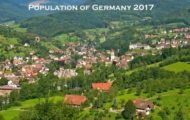Nigeria, is a federal constitutional republic in West Africa, bordering Benin in the west, Chad and Cameroon in the east, and Niger in the north. It comprises 36 states and its largest cities include Lagos, Kano, Ibadan, Benin City and Port Harcourt. Nigeria is officially a democratic secular country.

Nigeria is often referred to as the “Giant of Africa”, owing to its large population and economy. With approximately 184 million inhabitants, Nigeria is the most populous country in Africa and the seventh most populous country in the world. Nigeria has one of the largest populations of youth in the world. The country is inhabited by over 500 ethnic groups speaking over 500 different languages.The official language is English. Nigeria is divided roughly in half between Christians, who live mostly in the southern part of the country, and Muslims in the northern part.
As of 2015, Nigeria is the world’s 20th largest economy, worth more than $500 billion and $1 trillion in terms of nominal GDP and purchasing power parity respectively. It overtook South Africa to become Africa’s largest economy in 2014.
POPULATION OF NIGERIA IN 2017:
Talking about population, in order to check out the population of Nigeria in 2017, we need to have a look at the population of the past 5 years. They are as per the following:
- 2012 – 168.8 million
- 2013 – 173.6 million
- 2014 – 178.03 million
- 2015 – 182.2 million
- 2016 – 184.6 million
NIGERIA Population 2017 – 188.9 million(Estimated)
The current population of Nigeria is 188,906,160 as of 2016, based on the latest United Nations Estimates. Nigeria population is equivalent to 2.48% of the total world population.
The country has a huge youth population with an average median age 17.9 years old for both males and females. There are, according to estimates, about 1.04 males to every 1 female in the country.
As of 1 January 2016, the population of Nigeria was estimated to be 184 635 279 people. This is an increase of 2.67 % (4 796 305 people) compared to population of 179 838 974 the year before. In 2015 the natural increase was positive, as the number of births exceeded the number of deaths by 4 859 249. Due to external migration, the population declined by 62 944. With this growth rate of population, the estimated population of Nigeria in 2017 is 191,835,936.
According to our estimations, daily change rates of Nigeria population in 2016 will be the following:
20 391 live births average per day (849.62 in a hour)
6 723 deaths average per day (280.11 in a hour)
-177 emigrants average per day (-7.38 in a hour)
The population of Nigeria will be increased by 13 491 persons daily in 2016.
The total dependency ratio of population in Nigeria is 78.8 %. Child dependency ratio in Nigeria is 73.2 %. Aged dependency ratio in Nigeria is 5.6 % and total life expectancy (both sexes) at birth for Nigeria is 47.6 years that is very less than the International average life expectancy rate that stands at almost 71 years. The entire population of Nigeria accounts for about 2.35% of the entire earth’s population. This means that about 1 out of every 43 people in the world call Nigeria their home.
DEMOGRAPHY OF NIGERIA:
There are more than 250 ethnic groups in Nigeria, and out of them the most populous and politically influential are: Hausa and the Fulani 29%, Yoruba 21%, Igbo (Ibo) 18%, Ijaw 10%, Kanuri 4%, Ibibio 3.5%, Tiv 2.5% and the major religions are as follows- Muslim 50%, Christian 40%, indigenous beliefs 10%.
The official language of Nigeria is English, but the country does feature multiple languages. The most common non-English languages include the language of Hausa, the language of Yoruba, and the language of Igbo. Those three languages are the most widespread, apart from the language of English.
Population 188,906,160
Age structure
0-14 years: 42.79%
15-24 years: 19.48%
25-54 years: 30.65%
55-64 years: 3.96%
65 years and over: 3.12%
Dependency ratios
Total dependency ratio: 87.7%
Youth dependency ratio: 82.6%
Elderly dependency ratio: 5.1%
Birth rate 37.3 births and Death rate is 12.7 deaths per 1000 of population.
POPULATION DENSITY AND GROWTH RATE IN NIGERIA:
Nigeria population density is 199.9 people per square kilometer as of December 2016. Density of population is calculated as permanently settled population of Nigeria divided by total area of the country. Total area is the sum of land and water areas within international boundaries and coastlines of Nigeria. The total area of Nigeria is 923 770 km2 according to the United Nations Statistics Division.
The United Nations project that the overall population of Nigeria will reach about 398 million by the end of the year 2050. By 2100, if current figures continue, the population of Nigeria will be over 746 million. According to the Census Bureau of the United States, the population of Nigeria will reach 402 million people by the year 2050. With those numbers, Nigeria will become the third most populated country in the entire world, surpassing the United States in the near future.
The Population growth rate in Nigeria as per the 2016 census is 2.44%.
FACTS ABOUT NIGERIA:
1. The capital city is of Nigeria is Abuja, which was planned out and then built in the 1980s, officially replacing Lagos as the capital in 1991.
2. The currency of Nigeria is called the Naira.
3. The Benue River and the Niger River (which the country was named after) are the largest rivers in Nigeria, they join and empty into the large Niger Delta.
4. Poor healthcare, living conditions and a lack of access to good water means Nigeria has a low general standard of living. The life expectancy is very less in Nigeria.
5. Nigeria is richly naturally endowed and has high levels of oil reserves and relies a lot on crude oil exports.
6. Nigeria’s national basketball team qualified for the 2012 Olympics and the country has exported a number of players to America’s NBA including Hakeem Olajuwon.
Find latest Nigeria Population in 2018



